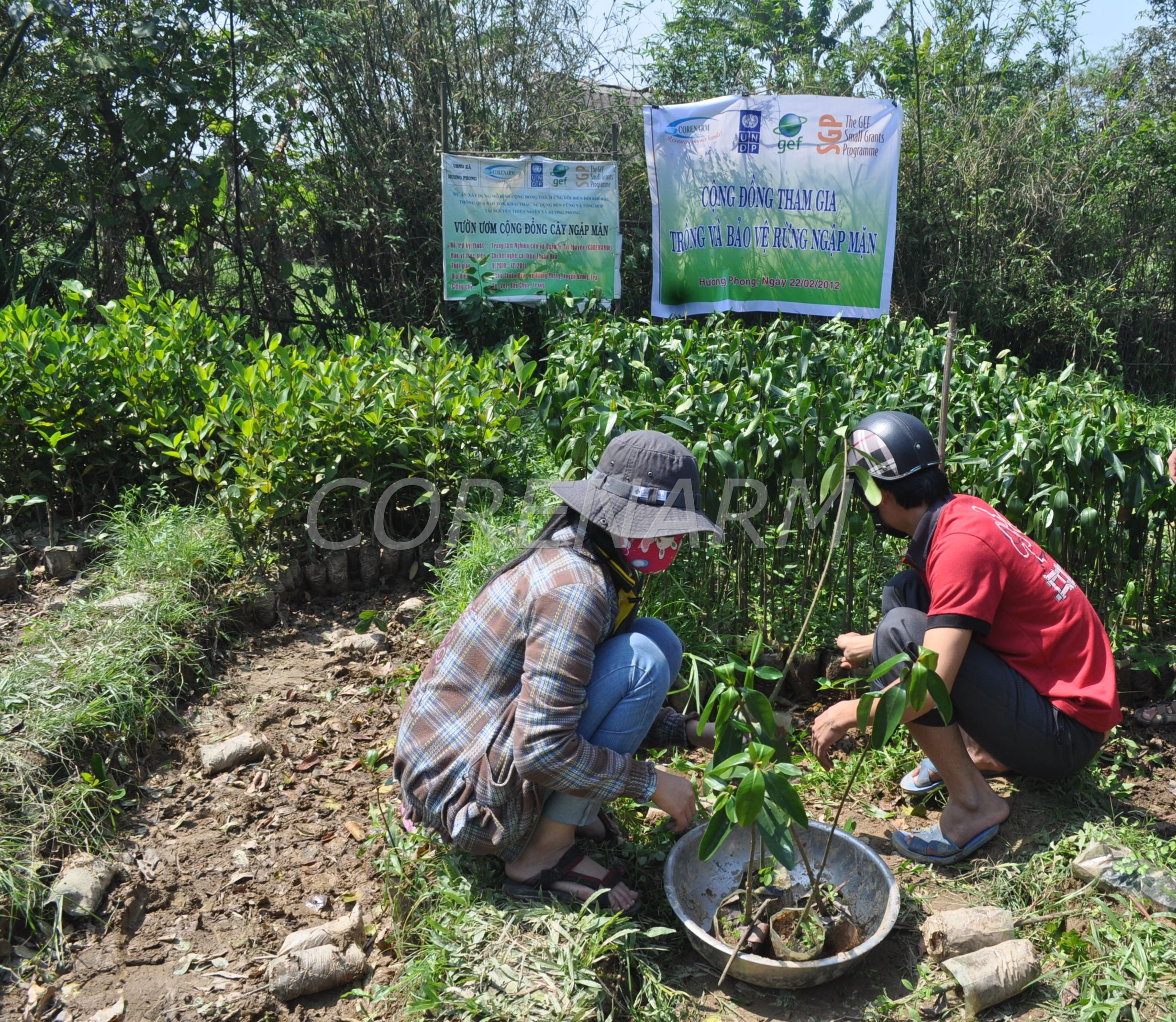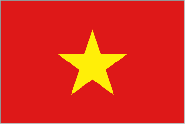CBA Viet Nam: Adaptation through Conservation and Sustainable Use of Natural Resources in Thua Thien Hue Province
Project Overview
Thua Thien Hue, a central province of Viet Nam, is greatly impacted by the effects of natural disaster. Extreme climate events reduce the mangrove forest’s ecology and buffering capacities, simultaneously threatening agricultural production. Property and lives are also endangered to some degree. Huong Phong, a small commune of about 12,000 residents, is located along the coast of the province. With a poverty rate above 20%, the population’s revenue is almost entirely based on agricultural production activities. Agricultural activities are highly dependent upon weather conditions, and are thereby frequently affected by natural disasters and salinity intrusion.
This Community-Based Adaptation project builds climate-adapted community models by conserving, exploiting and sustainably exploiting natural resources in Huong Phong commune. The project has been developed by the Consultative and Research Center on Natural Resource Management through a participatory process in which the community and local people took part in decision-making process. The project seeks to raise awareness and improve the capacity of local people to adapt to climate change impacts.
* This project is part of Viet Nam's Community-Based Adaptation portfolio. *
Project Details
Thua Thien Hue is located in the southernmost provinces of the north central region of Viet Nam. Its varied terrain features hills and mounds, coastal plains and coastal lagoons. Being in the tropical monsoon area, during the rainy season (August to November) Thua Thien Hue often suffers from floods and severe erosion.
Agricultural land in Huong Phong commune is mainly dedicated to rice cultivation. Production activities in Huong Phong commune are divided into two crops: the Winter - Spring crop lasts from January to May and the Summer - Fall crop lasts from May to August. Production activities in the Winter-Spring crop are more convenient due to abundant water resources. The Summer - Fall crop is usually difficult because salinity intrusion causes a lack of fresh groundwater for rice irrigation.
While there was once a large (20-25 ha) area of mangroves that extended along a neighboring lagoon, it has now been reduced to about 5 ha and is managed and protected by local people since 2001. The forest’s vitality has declined considerably, and some native species are permanently gone from the area. Local people have experienced bad effects of their deforestation in the past so they wish to protect what they still have.
Past and present human activities, coupled with the effects of climate change, are already harming the socio-economic situation in the province and will continue to have negative impacts for years to come. Adverse weather conditions here tend to occur with more and more serious repercussions. Huong Phong will be more seriously impacted by tidal intensity, rising sea levels and accompanying landslides, wetland and saltwater intrusion, and general land degradation on a large scale.
To strengthen local adaptation capacity, this project heavily involves community members in the decision-making process. This approach focuses on raising awareness through training courses and propaganda on the value of natural resources management for adaptation. Indigenous knowledge will be applied in the conservation and sustainable use of communal resources. Pilot models for sustainable management will be tested for mangrove forests and riverine ecosystems, enabling a diversified suite of income-generating activities.
The project also experiments to determine the suitable cultivation models most appropriate to local conditions given the trend of increasingly severe salt intrusion. These models will be developed on the basis of local knowledge and use the proven outcomes of related research. Adaptation to soil conditions and saline water will be addressed.
Key Results and Outputs
Outcome 1. Improve capacity for local authorities and community members on natural resources synthesized management to adapt to climate change;
Outcome 2. Build community-based models to manage and use natural resources sustainably to adapt to climate change;
Output 2.1. Contribute to conserving & developing mangrove forests and saline land to limit disaster and develop aquaculture in a sustainable way;
Output 2.2. Contribute to preventing land degradation due to saltwater intrusion through trials and summarize the experience of alternative models of local salt-resistant rice cultivation with freshwater fish and fisheries;
Output 2.3. Contribute to promoting the use of local salt-resistant rice species by restoring some rice species in order to improve quality and productivity leading to conserving agricultural bio-diversity;
Output 2.4. Develop community eco-tourism to vary local household income based on conserving, using and exploiting mangrove forest and native culture; and
Outcome 3. Document, evaluate, and summarize experiences and advise local authority and people on related issues in order to widen these models to similar sites in Thua Thien Hue in specific and Central Vietnam in general.
Reports and Publications
PIFs
CBA Viet Nam - Huong Phong (Thua Thien) - Project Proposal (EN)
Monitoring and Evaluation
Monitoring and evaluation for community-based adaptation is a new field, and the CBA project is piloting innovative approaches to evaluating the success of locally-driven adaptation projects, and generating lessons to inform ongoing practice.
Key considerations in M&E for CBA include:
- Grounding M&E in the local context: M&E for CBA should avoid overly rigid frameworks, recognizing community heterogeneity and maintaining local relevance
- Capturing global lessons from local projects: CBA projects are highly contextualized, but lessons generated should be relevant to stakeholders globally
- Incorporation of both quantitative and qualitative indicators: to ground projects in tangible changes that can be objectively evaluated, and to capture lessons and case studies for global dissemination
To these ends, the CBA project uses three indicator systems: the Vulnerability Reduction Assessment, the Small Grants Programme Impact Assessment System, and the UNDP Climate Change Adaptation Indicator Framework.
The Vulnerability Reduction Assessment (VRA)
The VRA is a question-based approach with the following aims:
- To make M&E responsive to community priorities
- To use M&E to make projects more accountable to local priorities
- To make M&E capture community ideas and local knowledge
- To gather community-level feedback to guide ongoing project management
- To generate qualitative information
- To capture lessons on specific issues within community-based adaptation
- To generate case studies highlighting adaptation projects
The VRA follows UNDP's Adaptation Policy Framework, and is measured in a series of meetings with local community stakeholders. In these meetings, locally-tailored questions based on standard VRA questions/indicators are posed, and the community assigns a numerical score on a 1-10 scale for each question. Progress is evaluated through changes in scores over the course of implementation, as well as through qualitative data collected in community discussions surrounding the exercise.
UNDP has developed a Users Guide to the VRA (Espanol) (Francais) as a tool to assist practitioners to conceptualize and execute VRA measurements in the context of CBA projects.
The SGP Impact Assessment System (IAS)
The CBA, being a project of the GEF Strategic Priority on Adaptation, aims to increase the resilience of ecosystems and communities to the impacts of climate change, generating global environmental benefits, and increasing their resilience in the face of climate change impacts. To this end, the CBA projects use the SGP's impact assessment system for monitoring achievements in GEF focal areas (focusing primarily on biodiversity and sustainable land management).
The IAS is composed of a number of quantitative indicators which track biophysical ecosystem indicators, as well as policy impact, capacity development and awareness-building.
UNDP Climate Change Adaptation Indicator Framework
CBA projects also track quantitative indicators from UNDP's adaptation indicator framework, corresponding to the thematic area on natural resources management. More information on UNDP's indicator framework can be found on the UNDP climate change adaptation monitoring and evaluation website.
* This description applies to all projects implemented through UNDP's Community-Based Adaptation programme. Specific details on this project's M&E will be included here as they become available. *




